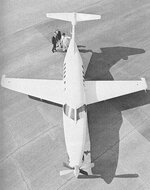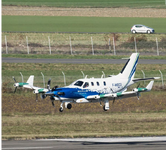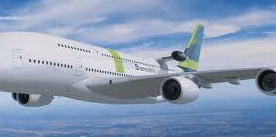Navigation
Install the app
How to install the app on iOS
Follow along with the video below to see how to install our site as a web app on your home screen.
Note: This feature may not be available in some browsers.
More options
Style variation
-
Congratulations cowski on being selected by the Eng-Tips community for having the most helpful posts in the forums last week. Way to Go!
You are using an out of date browser. It may not display this or other websites correctly.
You should upgrade or use an alternative browser.
You should upgrade or use an alternative browser.
not enough propellers ?
- Thread starter rb1957
- Start date
- Status
- Not open for further replies.
btrueblood
Mechanical
Is the turboprop there just because it always was, or do they just not want to trust their batteries yet?
LittleInch
Petroleum
The only one that seems to be rotating is the turbo prop....
GregLocock
Automotive
Perhaps the turboprop is [also] the source for electrical power for test flights?
For test-bed Acft this is a 'typical arrangement'.
For Giggles.... Here was an arrangement vetted in the 1970s. There was a turbo-prop hung on the nose... and a small 'fanjet-engine' for take-off/heavy in the fuselage tail-cone... supposedly for twin-engine safety and extra power for take-off and heavy-weight climb. Approaching cruise, the fanjet engine was 'shut-down and 'cowled-off' for the cruise fuel efficiency of the single low-powered TP engine. Hmmmm... or was that the other way-around... TPE shut-down and blades feathered... pushed by the small fan engine??? OH well... I thought this was an idea worth pursuing. I am sure there were 'issues... especially logistics RE 2-different engine types on one Acft... AND flying issues/characteristics/human-factors when one engine was shutdown for an extended period.



For test-bed Acft this is a 'typical arrangement'.
For Giggles.... Here was an arrangement vetted in the 1970s. There was a turbo-prop hung on the nose... and a small 'fanjet-engine' for take-off/heavy in the fuselage tail-cone... supposedly for twin-engine safety and extra power for take-off and heavy-weight climb. Approaching cruise, the fanjet engine was 'shut-down and 'cowled-off' for the cruise fuel efficiency of the single low-powered TP engine. Hmmmm... or was that the other way-around... TPE shut-down and blades feathered... pushed by the small fan engine??? OH well... I thought this was an idea worth pursuing. I am sure there were 'issues... especially logistics RE 2-different engine types on one Acft... AND flying issues/characteristics/human-factors when one engine was shutdown for an extended period.



Last edited:
SWComposites
Aerospace
the wing mounted props are designed to chop up drones
- Thread starter
- #11
I suspect it is a hydrid ... 6 small electric motors on the wings (so they can call it "carbon neutral" or maybe "reduced carbon") are not man (non-gender specific) enough for the job, so they have the turbo-prop ... maybe I'm mistaken, but it looks like the plane was designed for the turboprop and they strapped the electric motors on to experiment.
Your tax dollars/euros at work/play ...
Your tax dollars/euros at work/play ...
- Thread starter
- #12
Yeah, I've read quite some about it while doing my thesis. Probably they are trying to test the interaction with the wing, as there is gain when you increase flow velocity in front of a wing with respect to the lift generated, which could eventually lead to a more efficient configuration for electric aviation.
Even though you get other problems like you are more prone to whirl flutter, the propellers are smaller in size making them more inefficient, and well, you increase significantly the amount of propellers that can break... So in my inexperienced opinion, it looks better in paper than in reality, but tests are always needed to confirm or disprove hypothesis from simulations...
Even though you get other problems like you are more prone to whirl flutter, the propellers are smaller in size making them more inefficient, and well, you increase significantly the amount of propellers that can break... So in my inexperienced opinion, it looks better in paper than in reality, but tests are always needed to confirm or disprove hypothesis from simulations...
Last edited:
A B-52 has 8 engines on the wings; this has only 6.
If one is concerned about crazy ideas the B-52 was designed to take part in the ending of human civilization and that wack-a-doodle idea is still in force.
I can see some benefits to a hybrid - use the fuel operated engine for the energy expensive take-off and climb and then drop back to the higher efficiency of the far greater intercepted area of the electric fans while also having a demonstrable amount of flight time based on the fuel on board, something that electric propulsion hasn't come to grips with.
It is nowhere near the least practical or oddest configuration by a lot. Given current battery tech I'd say it is premature, but progress is not made by waiting.
If one is concerned about crazy ideas the B-52 was designed to take part in the ending of human civilization and that wack-a-doodle idea is still in force.
I can see some benefits to a hybrid - use the fuel operated engine for the energy expensive take-off and climb and then drop back to the higher efficiency of the far greater intercepted area of the electric fans while also having a demonstrable amount of flight time based on the fuel on board, something that electric propulsion hasn't come to grips with.
It is nowhere near the least practical or oddest configuration by a lot. Given current battery tech I'd say it is premature, but progress is not made by waiting.
- Thread starter
- #15
"there is gain when you increase flow velocity in front of a wing with respect to the lift generated" ... yes, I've heard about propeller slipstream !
I can't help thinking that this (propeller slipstream) and the rotational flow will mess enormously with the careful CFD of the wing ?
I can't help thinking that this (propeller slipstream) and the rotational flow will mess enormously with the careful CFD of the wing ?
That is indeed true, and in subsonic speeds the wing also significantly affects the flow upstream (at the propeller) so it's not that easy to see the effects of it. Simulations will give you insight but there is nothing like a well setup and test...
The main idea of this concept, if I remember correctly is that having this propeller configuration will help you to generate lift during take-off and landing, giving you freedom to have more slender and efficient wings for cruise speed (the propellers are folded at cruise, at least in the concept I studied).
The main idea of this concept, if I remember correctly is that having this propeller configuration will help you to generate lift during take-off and landing, giving you freedom to have more slender and efficient wings for cruise speed (the propellers are folded at cruise, at least in the concept I studied).
Last edited:
I did my MSc thesis in whirl flutter prediction for which this configuration are a nightmare, pretty fun though from a mathematical perspective. But the interaction between propeller and slender wings are quite prone to fatigue which can cause whirl flutter like the Lockheed L-188 Electra.
- Thread starter
- #18
I'm just wondering about the noise (different size props, presumably turning at different speeds) ... We were "threatened" with a similar project, managed to "drown that cat" !?
"surely" blades, even stowed fully feathered, make a awful mess of the aerodynamics of the wing ? Obviously not a laminar flow wing ...
"surely" blades, even stowed fully feathered, make a awful mess of the aerodynamics of the wing ? Obviously not a laminar flow wing ...
Lou Scannon
Automotive
- Status
- Not open for further replies.
Similar threads
- Replies
- 10
- Views
- 7K
- Replies
- 4
- Views
- 523
- Replies
- 4
- Views
- 954
- Replies
- 5
- Views
- 410
- Replies
- 5
- Views
- 509


